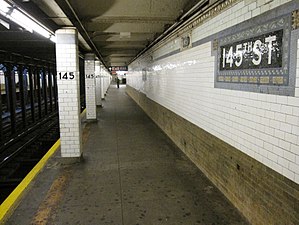145th Street station (IRT Broadway–Seventh Avenue Line)
145th Street | |||||||
|---|---|---|---|---|---|---|---|
 Uptown platform | |||||||
| Station statistics | |||||||
| Address | West 145th Street & Broadway New York, NY 10031 | ||||||
| Borough | Manhattan | ||||||
| Locale | Harlem, Hamilton Heights | ||||||
| Coordinates | 40°49′34″N 73°57′00″W / 40.826°N 73.95°W | ||||||
| Division | A (IRT)[1] | ||||||
| Line | IRT Broadway–Seventh Avenue Line | ||||||
| Services | 1 | ||||||
| Transit | |||||||
| Structure | Underground | ||||||
| Platforms | 2 side platforms | ||||||
| Tracks | 3 (2 in regular service) | ||||||
| Other information | |||||||
| Opened | October 27, 1904[2] | ||||||
| Opposite- direction transfer | No | ||||||
| Traffic | |||||||
| 2023 | 2,100,654[3] | ||||||
| Rank | 159 out of 423[3] | ||||||
| Station succession | |||||||
| Next north | Template:NYCS next | ||||||
| Next south | Template:NYCS next | ||||||
| |||||||
| |||||||
| |||||||
145th Street is a local station on the IRT Broadway–Seventh Avenue Line of the New York City Subway. Located at the intersection of Broadway and 145th Street in Harlem and Hamilton Heights, Manhattan, it is served by the 1 train at all times.
History
| style="color:;background:#Template:NYCS color;text-align:center;padding:5px"| Track layout | |||||||||||||||||||||||||||||||||||||||||||||||||||||||||||||||||||||||||||||||||||||||||||||||||||||||||||||||||||||||
|---|---|---|---|---|---|---|---|---|---|---|---|---|---|---|---|---|---|---|---|---|---|---|---|---|---|---|---|---|---|---|---|---|---|---|---|---|---|---|---|---|---|---|---|---|---|---|---|---|---|---|---|---|---|---|---|---|---|---|---|---|---|---|---|---|---|---|---|---|---|---|---|---|---|---|---|---|---|---|---|---|---|---|---|---|---|---|---|---|---|---|---|---|---|---|---|---|---|---|---|---|---|---|---|---|---|---|---|---|---|---|---|---|---|---|---|---|---|---|---|
| |||||||||||||||||||||||||||||||||||||||||||||||||||||||||||||||||||||||||||||||||||||||||||||||||||||||||||||||||||||||
Operation of the first subway began on October 27, 1904, with the opening of the original 28 stations of the New York City Subway from City Hall to 145th Street on the West Side Branch including the 145th Street station.[5][6]
In 1948, platforms on the IRT Broadway–Seventh Avenue Line from 103rd Street to 238th Street were lengthened to 514 feet to allow full ten-car express trains to platform. Previously the stations could only platform six car local trains. The platform extensions were opened in stages. On April 6, 1948, the stations from 103rd Street to Dyckman Street had their platform extensions opened, with the exception of the 125th Street, which had its extension opened on June 11, 1948.[7][8]
Station layout
| Ground | Street level | Exit/entrance |
| Platform level | Side platform | |
| Southbound local | ← | |
| Peak-direction express | ← | |
| Northbound local | | |
| Side platform | ||


This station has three tracks and two side platforms. The northbound local track merges with the center track north of the station and the line continues north as two tracks. The middle track from here south to 103rd Street is unused for revenue service. The platforms here are offset with the northbound one being slightly more to the south.
Just south of the station lies the underground 137th Street Yard, which is visible from passing trains. The track layout allows northbound trains to bypass this station by switching to the center express track in the 137th Street Yard south of the station. This was used when the 1 train ran skip-stop service with the 9 train from 1989–2005. During rush hours, 9 trains served this station while 1 trains bypassed it. Northbound 1 trains used the center express track and all southbound trains used only the southbound local track.
The platforms contain their original trim line of green with gray borders. "145" in white lettering on a dark border are tiled onto the trim. The station's other name tablets show "145TH ST." in a multi-color mosaic. The directional signs read also read "145TH ST." in white lettering on a black border. The station's columns, which run entirely along both platforms, are I-beams with a blue trim and "145" in black numbers.
This was the northern terminal station of the original IRT subway on opening day, which operated from City Hall.
Exits
Both platforms have same-level fare control containing a bank of turnstiles, token booth, and staircases to the street. The northbound platform has two staircases (one to each eastern corner of Broadway and 145th Street) and the southbound platform has a single staircase to the northwestern corner. There are no crossovers or crossunders to allow transfers between directions.[9]
References
- ^ "Glossary". Second Avenue Subway Supplemental Draft Environmental Impact Statement (SDEIS) (PDF). Vol. 1. Metropolitan Transportation Authority. March 4, 2003. pp. 1–2. Archived from the original (PDF) on February 26, 2021. Retrieved January 1, 2021.
- ^ New York Times, Our Subway Open: 150,000 Try It, October 28, 1904
- ^ a b "Annual Subway Ridership (2018–2023)". Metropolitan Transportation Authority. 2023. Retrieved April 20, 2024.
- ^ "Annual Subway Ridership (2018–2023)". Metropolitan Transportation Authority. 2023. Retrieved April 20, 2024.
- ^ James Blaine Walker, Fifty Years of Rapid Transit, 1864-1917, published 1918, pp. 162-191
- ^ "New York City subway opens - Oct 27, 1904". history.com. 1904-10-27. Retrieved 2015-10-25.
- ^ Report for the three and one-half years ending June 30, 1949. New York City Board of Transportation. 1949.
- ^ "More Long Platforms – Five Subway Stations on IRT to Accommodate 10-Car Trains". The New York Times. 1948-07-10. p. 8. ISSN 0362-4331. Retrieved 2016-03-27.
- ^ "MTA Neighborhood Maps: Harlem/Hamilton Heights" (PDF). Metropolitan Transportation Authority. 2015. Retrieved 18 July 2016.
External links

- nycsubway.org – IRT West Side Line: 145th Street
- Station Reporter – 1 Train
- Forgotten NY – Original 28 – NYC's First 28 Subway Stations
- The Subway Nut – 145th Street Pictures
- 145th Street entrance from Google Maps Street View
- Platforms from Google Maps Street View




